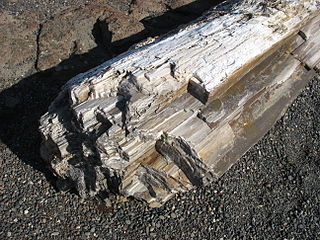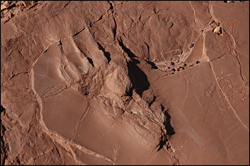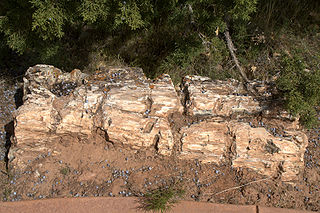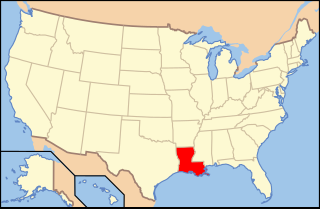
Petrified Forest National Park is a national park of the United States in Navajo and Apache counties in northeastern Arizona. Named for its large deposits of petrified wood, the park covers about 346 square miles, encompassing semi-desert shrub steppe as well as highly eroded and colorful badlands. The park's headquarters is about 26 miles (42 km) east of Holbrook along Interstate 40 (I-40), which parallels the BNSF Railway's Southern Transcon, the Puerco River, and historic U.S. Route 66, all crossing the park roughly east–west. The site, the northern part of which extends into the Painted Desert, was declared a national monument in 1906 and a national park in 1962. The park received 644,922 recreational visitors in 2018.

Petrified wood, is the name given to a special type of fossilized wood, the fossilized remains of terrestrial vegetation. Petrifaction is the result of a tree or tree-like plants having been replaced by stone via a mineralization process that often includes permineralization and replacement. The organic materials making up cell walls have been replicated with minerals. In some instances, the original structure of the stem tissue may be partially retained. Unlike other plant fossils, which are typically impressions or compressions, petrified wood is a three-dimensional representation of the original organic material.

Ginkgo Petrified Forest State Park/Wanapum Recreational Area is a geologic preserve and public recreation area covering 7,124-acre (2,883 ha) on the western shoreline of the Columbia River's Wanapum Reservoir at Vantage, Washington. Petrified wood was discovered in the region in the early 1930s, which led to creation of the state park as a national historic preserve. Over 50 species are found petrified at the site, including ginkgo, sweetgum, redwood, Douglas-fir, walnut, spruce, elm, maple, horse chestnut, cottonwood, magnolia, madrone, sassafras, yew, and witch hazel.

The National Natural Landmarks (NNL) Program recognizes and encourages the conservation of outstanding examples of the natural history of the United States. It is the only national natural areas program that identifies and recognizes the best examples of biological and geological features in both public and private ownership. The program was established on May 18, 1962, by United States Secretary of the Interior Stewart Udall.

Delta National Forest is a U.S. National Forest in western Mississippi, located in Sharkey County, and has an area of 60,898 acres (246.4 km2). Delta is operated as the Sunflower Wildlife Management Area. The forest is headquartered in Jackson, as are all six National Forests in Mississippi, but Delta Ranger District office is located in Rolling Fork. It is one of only six National Forests that are contained entirely within a single county and the only bottomland hardwood forest in the National Forest system.

Gojirasaurus is a genus of "coelophysoid" theropod dinosaur from the Late Triassic of New Mexico. It is named after the giant monster movie character Godzilla, and contains a single species, Gojirasaurus quayi.

The Lesvos Petrified Forest is a petrified wood forest on the island of Lesbos, Greece.
Winifred Goldring was an American paleontologist whose work included a description of stromatolites, as well as the study of Devonian crinoids. She was the first woman in the nation to be appointed as a State Paleontologist.
The Lake Macquarie Petrified Forest is a petrified pine tree forest at Fennell Bay, Lake Macquarie, New South Wales, Australia. Geologically it is located in the Permo-Carboniferous strata. The nearest town is Swansea.

Riker Hill Fossil Site is a 16-acre (6.5 ha) paleontological site in Roseland in Essex County, New Jersey, United States, located at the south western side of the borough at the border between Roseland and Livingston. It is one of the major sites in United States where a large number of dinosaur tracks are preserved. It was declared a National Natural Landmark in June 1971.

Sunfish Pond is a 44-acre (18 ha) glacial lake surrounded by a 258-acre (104 ha) hardwood forest located on the Kittatinny Ridge within Worthington State Forest, adjacent to the Delaware Water Gap National Recreation Area in Warren County, New Jersey. The Appalachian Trail runs alongside the western and northern edges of the lake. It was created by the Wisconsin Glacier during the last ice age. The lake was declared a National Natural Landmark in January 1970.

Prehistoric Trackways National Monument is a national monument in the Robledo Mountains of Doña Ana County, New Mexico, United States, near the city of Las Cruces. The monument's Paleozoic Era fossils are on 5,255 acres (2,127 ha) of land administered by the Bureau of Land Management. It became the 100th active U.S. national monument when it was designated on March 30, 2009.

Escalante Petrified Forest State Park is a state park in Utah, United States, located 0.8 km north of Escalante and 71 km east of Bryce Canyon National Park. The park features a high mesa that was once an ancient floodplain. Approximately 135 to 155 million years ago, large trees were buried in mud during floods. Groundwater eventually replaced the organic material with silica, preserving the wood as fossils. Erosion has exposed these petrified logs, which were prized by hobbyists before the park's establishment. The logs are believed to be from conifers transported by a river before being buried and fossilized as agate.

Paleontology in Mississippi refers to paleontological research occurring within or conducted by people from the U.S. state of Mississippi. The oldest rocks in Mississippi date back to the Late Devonian. At the time, the northeastern part of the state was covered in a sea where brachiopods, crinoids, and trilobites lived. Remains of contemporary local plants also ended up preserved in this environment. During the Late Carboniferous, Mississippi became part of a richly-vegetated coastal plain environment. There are no rocks dating to the Permian, Triassic, or Jurassic in the state. However, during the Cretaceous, evidence suggests that the state was covered by a sea home to cephalopods, mosasaurs and sharks. Local trees left behind petrified wood and amber. By the Cenozoic, only the southern half of the state was covered in seawater, where the early whale Basilosaurus lived. On land, trees that were home to some of the earliest known primates left behind petrified wood. For the remainder of the Cenozoic, the state's climate cooled. Many fossils have been serendipitously discovered in the state by people looking for fossil fuels. Significant fossil finds in Mississippi include some of the oldest known primate fossils. The Eocene whales Basilosaurus cetoides and Zygorhiza kochii are the Mississippi state fossils.

Paleontology in Louisiana refers to paleontological research occurring within or conducted by people from the U.S. state of Louisiana. Outcrops of fossil-bearing sediments and sedimentary rocks within Louisiana are quite rare. In part, this is because Louisiana’s semi-humid climate results in the rapid weathering and erosion of any exposures and the growth of thick vegetation that conceal any fossil-bearing strata. In addition, Holocene alluvial sediments left behind by rivers like the Mississippi, Red, and Ouachita, as well as marsh deposits, cover about 55% of Louisiana and deeply bury local fossiliferous strata.

A substantial amount of paleontological research has occurred within or conducted by people from the United States. Paleontologists have found that at the start of the Paleozoic era, what is now "North" America was actually in the southern hemisphere. Marine life flourished in the country's many seas. Later the seas were largely replaced by swamps, home to amphibians and early reptiles. When the continents had assembled into Pangaea drier conditions prevailed. The evolutionary precursors to mammals dominated the country until a mass extinction event ended their reign.
















